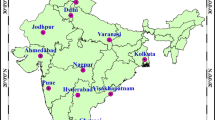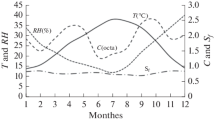Abstract
A modified solar radiation model, incorporating into several satellites remote sensing information such as NCEP/NCAR data, EOS-AURA satellite data, and Chinese FY-2C geo-stationary meteorological satellite data, is presented. The model is an attempt to modify Chen’s radiation model and examine its estimation accuracy at various places in six different climatic zones of China. The verification of model is also carried out by comparing between calculated radiation value using modified model and radiation product of FY-2C satellites. According to the NSE values, the adaptability of model is reasonably high in Mid-Temperate Zone (MTZ), Warm Temperate Zone (WTZ), Tibetan Plateau Zone (TPZ), and Cold Temperature Zone (CTZ) climate regimes and slightly low in Subtropical Zone (SZ) and Tropical Zone (TZ) climate regimes. The comparison between modeled radiation values and FY-2C radiation product values shows that the radiation product of FY-2C satellites is superior to the modified model in SZ and TZ climate regimes.




Similar content being viewed by others
References
Bird RE, Hulstrom RL (1979) Application of Monte Carlo techniques to insolation characterization and prediction. Report SERI-RR-36-306, SERI, Golden, CO
Chen RS, Lu SH, Kang ES, Yang JP, Ji XB (2006) Estimating daily global radiation using two types of revised models in China. Energy Convers Manage 47(7):865–878
Chen RS, Kang ES, Ji XB, Yang JP, Wang JH (2007) An hourly solar radiation model under actual weather and terrain conditions: a case study in Heihe river basin. Energy 32:1148–1157
EI-Sebaii AA (2003) Estimation of horizontal diffuse solar radiation in Egypt. Energy Convers Manage 44:2471–2482
Inci TT, Emin O (1999) A study for estimating solar radiation in Elaziğ using geographical and meteorological data. Energy Convers Manage 40:1577–1584
Janjaia S, Pankaewa P, Laksanaboonsonga J, Kitichantaropasb P (2011) Estimation of solar radiation over Cambodia from long-term satellite data. Renew Energy 36(4):1214–1220
Kalnay E, Kanamitsu M, Kistler R, Collins W, Deaven D, Gandin L et al (1996) The NMC/NCAR 40-year reanalysis project. Bull Am Meteorol Soc 77(3):437–472
Lohmann S, Schillings C, Mayer B, Meyer R (2006) Long-term variability of solar direct and global radiation derived from ISCCP data and comparison with reanalysis data. Sol Energy 80:1390–1401
Martins FR, Pereira EB, Abreu SL (2003) Satellite-derived solar resource maps for Brazil under SWERA project. Sol Energy 81:517–528
Nash JE, Sutcliffea JV (1970) River flow forecasting through conceptual models part 1. A discussion of principles. J Hydrol 10(3):282–290
Perez R, Ineichen P, Moore K, Kmiecik M, Chain C, George R et al (2002) A new operational model for satellite-derived irradiances: description and validation. Sol Energy 73(5):307–317
Schillings C, Mannstein H, Meyer R (2004) Operational method for deriving high resolution direct normal irradiance from satellite data. Sol Energy 76:475–484
Torres O, Tanskanen A, Veihelmann B, Ahn C, Braak R, Bhartia PK et al (2007) Aerosols and surface UV products from ozone monitoring instrument observations: an overview. J Geophys Res 112:D24S47. doi:10.1029/2007JD008809
Uppala SM, KÅllberg PW, Simmons AJ, Andrae U, Bechtold VD, Fiorino M et al (2005) The ERA-40 re-analysis. Q J R Meteorol Soc 131:2961–3012
Vignolaa F, Harlana P, Perezb R, Kmiecikb M (2007) Analysis of satellite derived beam and global solar radiation data. Sol Energy 81(6):768–772
Wang B, Yang ST, Lii CW, Zhang J, Wang YJ (2010) Comparison of net primary productivity in karst and non-karst areas: a case study in Guizhou Province, China. Environ Earth Sci 59:1337–1347
Yang K, Koike T, Ye BS (2006) Improving estimation of hourly, daily, and monthly solar radiation by importing global data sets. Agric For Meteorol 137:43–55
Yuan WP (2012) Surface incidence solar radiation of FY2 satellite data. FENGYUN Satellite Date Center. http://219.239.44.149/PortalSite/StaticContent/UserTraining.aspx?ID=2. Accessed 21 Aug 2012 (in Chinese)
Zang HX, Xu QS, Bian HH (2012) Generation of typical solar radiation data for different climates of China. Energy 38:236–248
Acknowledgments
This work is supported by the Knowledge Innovation Project of National Natural Science Foundation of China (No. 91025011, No. 91125013 and No. 41222001), and Energy Efficiency Management and Innovation teamwork (PHR201007136). The author would also like to thank China Meteorological Administration for its data support.
Author information
Authors and Affiliations
Corresponding author
Rights and permissions
About this article
Cite this article
Qing, W., Chen, R. & Sun, W. Estimation of global radiation in China and comparison with satellite product. Environ Earth Sci 70, 1681–1687 (2013). https://doi.org/10.1007/s12665-013-2255-9
Received:
Accepted:
Published:
Issue Date:
DOI: https://doi.org/10.1007/s12665-013-2255-9




